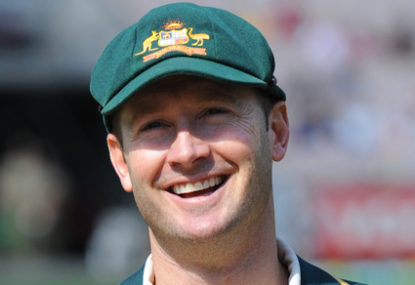Nudge
new author
Roar Rookie

If the recent trend is to be continued, Australia needs to bat first at Cape Town to have any chance of winning this series against South Africa.
Of the past 12 Tests, stretching through two Ashes series and the first two Tests against South Africa, Australia have batted first in seven matches for five wins and two draws.
In the two drawn matches, Australia were well on top and on the way to victory, only to be thwarted by some poor English weather.
In the other five Tests where Australia have batted second, we have lost four and won one, with the sole victory coming at the MCG when England held all the cards until late in the game.
England scored 255 in their first innings and then had Australia on the racks at 9 for 164. Only a 40 run partnership from Brad Haddin and Nathan Lyon and some inept captaincy from Alastair Cook took the first innings total to 204 and a deficit of 51.
From there England managed to get to 5 for 173, so really 5 for 224 and in control of the match, only to inexplicably lose 5 for 6 to leave Australia chasing 231 for victory.
At this stage of the series England were clearly shot and I would argue any half decent team in world cricket should win from a position of 5 for 224 in the second innings.
Another trend that has been mentioned since the Port Elizabeth Test is that Australia’s batsmen don’t have the patience or ability to bat on slow, dry wickets.
While this has some merit, the two times we batted first in England on slow, dry wickets we racked up scores of 7 for 527 in the third Test and 9 for 492 in the fifth Test.
And the only dry wicket during the Australian leg, in Adelaide, Australia batted first and scored 9 for 570.
So no problems batting first on a slow wicket in those games.
We hear a lot about scoreboard pressure being applied to AFL football, it should also be applied to Test match cricket.
Runs on the board is hugely important and, as we’ve seen in the recent past, this Australian team can tally up huge totals when batting first but when set a first innings score we become inept in the chase.
I know some people may look to last year’s Indian series, where we batted first in every match and got smoked four nil, but as we now know the change rooms had a toxic environment and the selectors had a shocker with Moises Henriques playing three Tests, Glenn Maxwell two Tests, Xavier Doherty two, Matthew Wade three, Ed Cowan four and Phil Hughes – who I feel may become a good Test cricketer at some stage – four Tests, even though at this stage he is a dreadful player of spin.
Australian totals batting first in the past 12 Tests – 7 for 527, 9 for 492, 295, 9 for 570, 385, 326, 397.
Australia’s totals batting second – 280, 128, 270, 204, 246.
So our worst first innings total is 15 runs better than our best second innings total. Batting first seven times – total runs 2992 at an innings average of 427.
Batting second five times – 1128 runs at an inning average of 225.
Runs per wicket batting first – 46.
Runs per wicket batting second – 22.
So the most nervous part of the Test for me will be when the two skippers go out to toss the coin.
But who knows – if we lose it, trends are made to be broken.
Fingers crossed.